
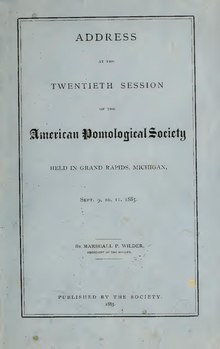
The American Pomological Society was founded by Marshall Pinckney Wilder in 1848, to foster the growing of fruit and the development of new varieties, and is the oldest fruit organization in North America. [1]


The American Pomological Society was founded by Marshall Pinckney Wilder in 1848, to foster the growing of fruit and the development of new varieties, and is the oldest fruit organization in North America. [1]
The organization's primary publication is the Journal of the American Pomological Society. This journal was previously known as the Fruit Varieties Journal. The society also publishes the Register of Fruit and Nut Varieties in cooperation with the American Society for Horticultural Science. [1]
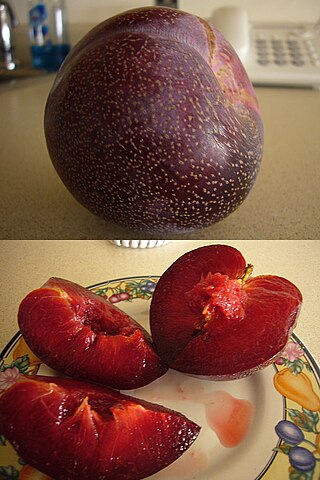
Pluots, apriums, apriplums, plumcots, plumpicots, or pluclots are some of the hybrids between different Prunus species that are also called interspecific plums. Whereas plumcots and apriplums are first-generation hybrids between a plum parent and an apricot, pluots and apriums are later-generations. Both names "plumcot" and "apriplum" have been used for trees derived from a plum seed parent, and are therefore equivalent.
Chris "Floyd" Zaiger was an American fruit breeder particularly known for hybrid development of stone fruit and numerous plant patents. Zaiger founded Zaiger's Genetics, a fruit-breeding business in Modesto, California, which is now an international business selling cultivars and hybrids. Zaiger developed varieties such as the pluot, and has been called "the most prolific stone fruit breeder in the modern era."

Lue Gim Gong was a Chinese-American horticulturalist. Known as "The Citrus Wizard", he is remembered for his contribution to the orange-growing industry in Florida.

The damson or damson plum, also archaically called the "damascene", is an edible drupaceous fruit, a subspecies of the plum tree. Varieties of insititia are found across Europe, but the name damson is derived from and most commonly applied to forms that are native to Great Britain. Damsons are relatively small ovoid plum-like fruit with a distinctive, somewhat astringent taste, and are widely used for culinary purposes, particularly in fruit preserves and jams.

Pomology is a branch of botany that studies fruits and their cultivation. Someone who researches and practices the science of pomology is called a pomologist. The term fruticulture is also used to describe the agricultural practice of growing fruits in orchards.
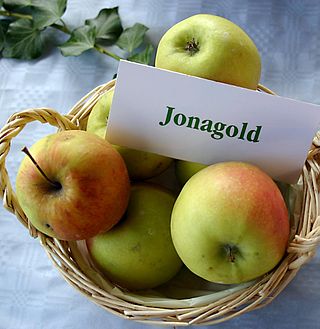
Jonagold is a cultivar of apple that is a cross between the crisp Golden Delicious and the blush-crimson Jonathan; the name Jonagold is a portmanteau of these two variety names. It was developed in 1943 in New York State Agricultural Experiment Station of Cornell University's College of Agriculture and Life Sciences, selected as N.Y. 43013-1 in 1953, officially released in 1968 by Roger Way.

'Ralls Janet' is an apple cultivar that is also known by many other names. It has been used extensively in modern apple breeding, and has several commercially important offspring. It was grown at Monticello by Thomas Jefferson.

Griotte de Kleparow is a dark-red morello, or Griotte, type of cherry which originated from the outskirts of Lviv, modern Ukraine.

George McMillan Darrow (1889–1983) was an American horticulturist and the foremost authority on strawberries. He worked for the United States Department of Agriculture (USDA-ARS) for forty-six years as the pomologist in charge of research on deciduous fruit production, and authored a multitude of papers on planting and cultivating small fruits.
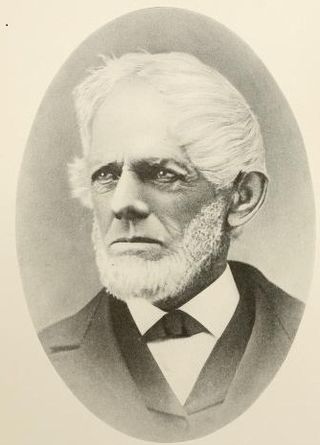
Charles Downing, was an American pomologist, horticulturist, and author.
Arthur Bridgman Howard was an American horticulturalist.
Rogers Orchards, in Southington, Connecticut, is an agricultural-produce company owned and operated by members of the same family since its founding in 1807 and one of the leading agricultural producers in Connecticut.
Niels Ebbesen Hansen was a Danish-American horticulturist, botanist, and agricultural explorer for the United States Department of Agriculture and the state of South Dakota. He searched the harsh environments of northern Scandinavia, Siberia, Manchuria, and the dry steppes of the Volga for plant stock that could flourish on the upper Great Plains.

Marshall Pinckney Wilder was an American actor, monologist, humorist and sketch artist.
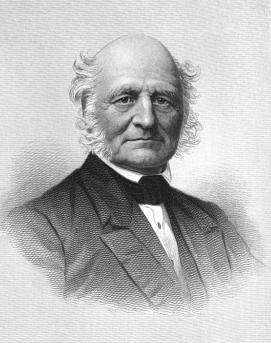
Marshall Pickney Wilder was a Massachusetts merchant, amateur horticulturalist, and politician who served in the Massachusetts House of Representatives, on the Massachusetts Governor's Council as a member and President of, the Massachusetts Senate.
Albert Etter (1872–1950) was an American plant breeder best known for his work on strawberry and apple varieties.
James Marion Shull (1872–1948) was an American botanist known for his iris and daylily cultivars and botanical illustrations.
The Churchland or Church is a cultivar of the European pear, it was developed in New Rochelle, New York in northeastern United States. It is believed to have originated as a seedling raised by one of the early Huguenot settlers of the village in the late 17th century. The original tree stood on land which was owned by the Trinity St. Paul's Church of New Rochelle, hence the naming of the fruit "Church". The fruit was so luscious that it was universally liked and, by grafting, the tree soon had extensive propagation throughout the country. An early account of the tree appeared in the proceedings of the American Pomological Society in 1856.

The U.S. Department of Agriculture's Pomological Watercolor Collection is an archive of some 7,500 botanical watercolors created for the USDA between the years 1886 and 1942 by around five dozen artists. Housed by the United States National Agricultural Library, it is a unique resource documenting existing fruit and nut cultivars, new introductions, and specimens discovered by USDA's plant explorers, representing 38 plant families in all. It has been called "one of the world's most unusual holdings of late 19th and early 20th century American botanical illustrations".

Mary Daisy Arnold was a botanical artist who worked for the United States Department of Agriculture (USDA) for over thirty-five years, painting watercolors of a wide variety of fruits. She is one of the three most prolific artists whose work is now preserved in the USDA's Pomological Watercolor Collection.